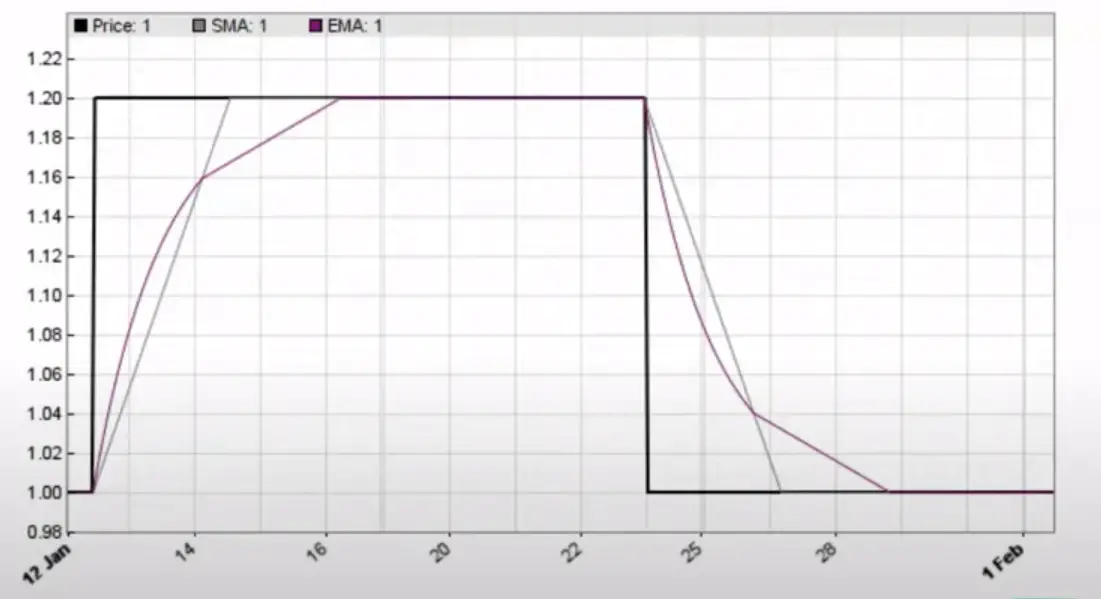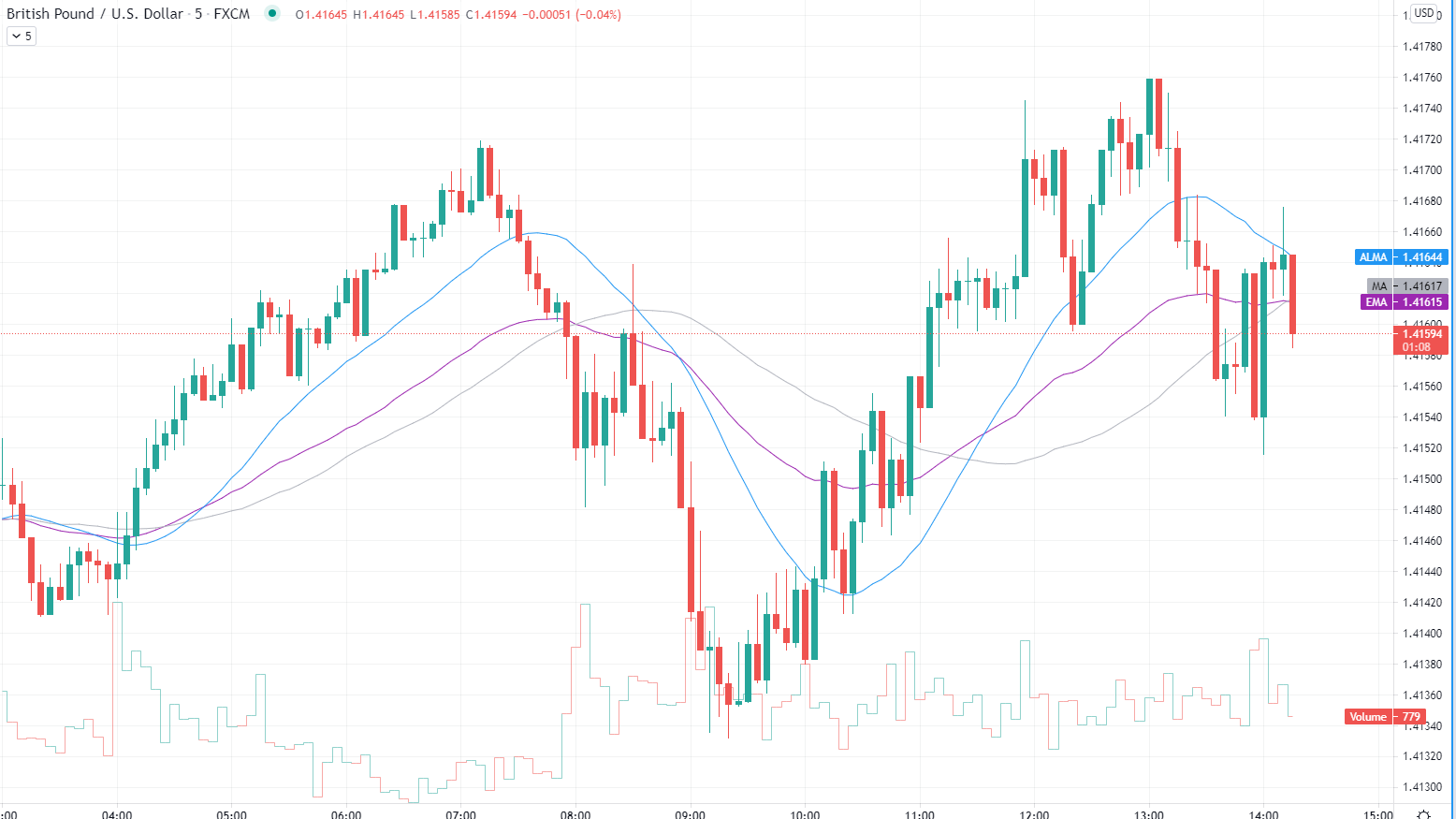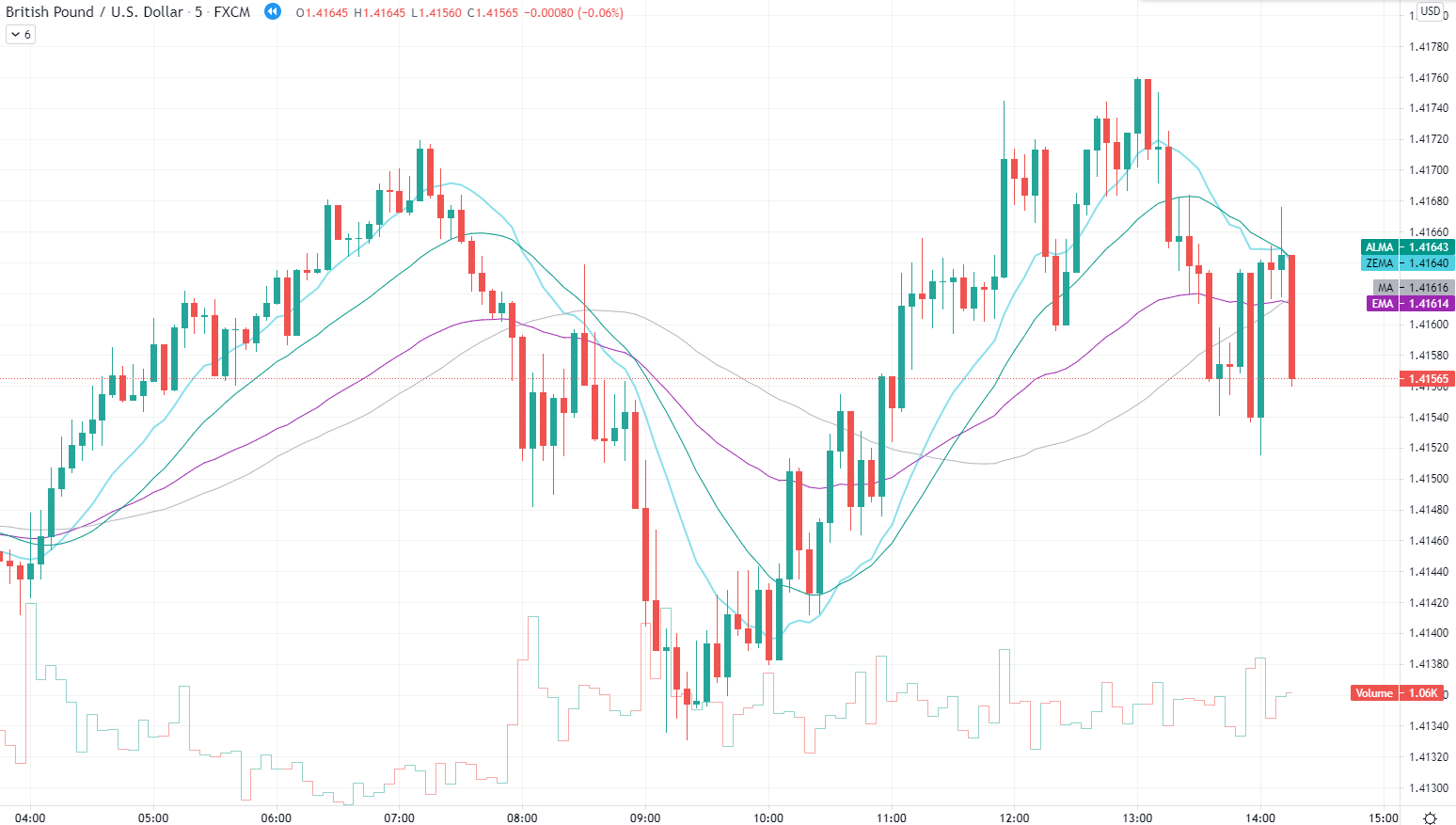Do you use moving averages in your trading? Do you have a trading strategy that is based on simple moving averages (SMAs) or exponential moving averages (EMAs) but feels that your performance could be better if the MAs were faster and more precise?
Fortunately, there are other moving averages besides the super-popular SMAs and EMAs. Each comes with its own pros and cons as there is no single indicator with superpowers, but they are faster, more accurate, and less lagging than SMAs and EMAs.
Here, we’ll cover some less-known MAs and show you How to Reduce Lag in Moving average.
Types of MAs
Most of you have heard of the two popular types of moving averages that most retail traders are using: Simple Moving Averages (SMAs) and Exponential Moving Averages (EMAs).
Simple moving averages take a pre-defined number of previous closing prices, calculate an arithmetic mean of the prices, and plot it on the chart. They are usually the slowest type of moving averages, as each closing price has the same weight in the calculation.
For example, if you apply an SMA of 10 periods to a 1-hour chart, the closing price of 10 hours ago will have the same importance in the calculation as the closing price of 1 hour ago.
Exponential Moving Averages are somewhat quicker to react to recent price changes as they use exponential calculating in their algorithms. If we take the same example as above, then the closing price of 1 hour ago will be more important and have more weight in the calculation than the closing price of 10 hours ago.
Here is how SMAs and EMAs compare to each other on a simple (artificial) price chart, where the price jumps from 1.00 to 1.20 and drops from 1.20 to 1.00 again. Note that this is no real price chart, but it still provides a good background for understanding how different types of moving averages follow the price.

In the chart above, the black line represents our simple price chart. The gray line is an SMA and the purple line is an EMA. An SMA plots a straight line from 1.00 to 1.20 as the price rises as it uses simple arithmetic means in its computing.
EMAs use geometric means and are quicker to react to the most recent price changes, which can be seen with the purple line on the chart. Interestingly, if you look closer, EMAs are actually slower to reach the 1.20 level, which makes them less suitable for identifying exit points than SMAs.
- ALMA – Arnaud Legoux MA
The Arnaud Legoux Moving Average, also known as ALMA, is much quicker to react to recent price changes than an Exponential Moving Average. ALMA removes small price fluctuations by applying two moving averages at the same time, one from left to right, and one from right to left.
Here is how the ALMA compares to SMAs and EMAs. ALMA is represented with the green line.

As you can notice, the ALMA indicator follows the price closely after it jumps to 1.20 and is the first indicator to touch the level. The same applies when the price drops from 1.20 to 1.00, ALMA is the fastest moving average of the three.
Here is how ALMA looks like on a real price chart of GBPUSD, together with an SMA (silver) and an EMA (purple)

When to use ALMA? You should use ALMA instead of SMAs and EMAs when extreme speed is a major consideration for your trading style and strategy, such as in scalping.
- Zero Lag MA
A Zero Lag Moving Average is based on the idea of applying an EMA to de-lagged data, instead of doing it on regular data. As its name implies, Zero Lag MAs aim to reduce the lag that comes with other trend-following indicators and moving averages.
While Zero Lag MAs are quicker than Arnaud Legoux MAs to react to recent price changes, it’s slower to reach the price once the market stabilizes. This can be seen on the following chart. Note that the Zero Lag MA is represented with the turquoise color.

Here is how the indicator looks like on a real GBP/USD price chart. Notice that the indicator is the quickest to follow the price, but is slower than the ALMA indicator to identify market tops and bottoms.

When to use Zero Lag MA? You should use a Zero Lag MA when speed is important for your trading, but not the ability to identify tops or bottoms.
- Hull MA
Another type of moving averages that are designed to reduce lag to recent price changes is the Hull MA. Unlike traditional MAs like the SMA or EMA, the Hull MA provides a faster and smoother signal. Just like with other MAs, it’s important to understand the balance between providing accurate signals and being the fastest MA out there. A trader can’t get the best of both worlds.
An important characteristic of the Hull MA is its tendency to overshoot price targets to the upside when prices are rising, and to the downside when prices are falling. In terms of speed, the indicator lies somewhere in between the Zero Lag MA and the ALMA. This can be seen on the following chart.

The overshooting characteristic of the Hull MA makes it less precise than other types of MAs in times of high market volatility. However, this is what makes the Hull MA the first to reach the new price level when prices rise dramatically to the upside or downside.
A real-world example of the Hull MA, together with the other types of MAs covered so far, can be seen on the following chart.

When to use the Hull MA? You should use the Hull MA when catching the tops and bottoms are very important in your trading strategy. To be able to catch tops and bottoms, you will have to sacrifice some speed compared to the Zero Lag MA, but not to a large extent.
In addition, since the Hull MA tends to overshoot price levels, accuracy is not the best selling point of the indicator.
- Decycler MA
The Decycler MA is based on spectrum and signal analysis and applies those algorithms to the world of financial markets. This MA is one of the fastest MAs out there, but it also tends to overshoot price levels. However, the degree of overshooting levels is around half of the Hull MA.
Here you can see the Decycler MA in action, represented in pink. The speed of the indicator is incredibly high, while the overshooting distance is around 10-15 percent in times of high market volatility.

When to use the Decycler MA? You should use the Decycler MA when speed is paramount to your trading style, and you don’t care about hitting the exact tops or bottoms in times of strong price movements.
- Low Pass Filter
The Low Pass Filter is another indicator that comes from the area of signal processing and electrical engineering. The filter is commonly used to smooth an array of sampled data, which means the algorithm can also be used in trading and financial markets.
Here is how the Low Pass Filter compared to other types of MAs. The Low Pass Filter MA is shown in red.

In terms of speed, the LPF is not the fastest out there. It closely follows the speed of the ALMA, but tends to overshoot to the downside when prices are rising, and to the downside when prices are falling. This is no surprise given that the LFP has been primarily designed for electrical engineering applications and signal processing.
When to use the Low Pass Filter? You should use the LPF when you need to faster MA than the EMA, but as fast as the Decycler or Zero Lag MAs. However, you still want that “overshoot effect” in your moving average.
- Smoothed MA a.k.a. Smoother
The Super Smoother is a Smoothed Moving Average that uses a longer period to determine the average closing prices, assigning a different weight to each closing price as the average is calculated. Unlike in EMAs, the oldest price data in a Smoothed Moving Average is never removed, but its weight is getting smaller and smaller as new price information comes in.
The Smoother MA is therefore best suited to smooth out the underlying price volatility and short-term fluctuations, leaving a view of the prevailing trend.
Here is how the Smoother compares to other types of moving averages. The Smoother MA is represented in blue.

When to use the Super Smoother MA? Just like the Low Pass Filter, the Super Smoother lies in the middle in terms of speed compared to other types of MAs. However, the overshooting of highs and lows is minimal, allowing traders to still take advantage of this characteristic in their trading.
How to Get More Accurate Entries and Exits?
Now that you know how different types of MAs can be used to reduce lag and increase sensitivity to recent price changes, let’s see how you can use MAs to precisely define your entry and exit levels.
- MA Crossovers
Whether you’re using Hull MAs, Low Pass Filters, or a Simple Moving Average, you can add MA crossovers to your trading strategy to get precise entry and exit points for your trades. To add MA crossovers to your trading, you need to add two MAs to your screen: a fast and a slow MA. A fast MA is the signal MA, as it provides a trading signal when it crosses above or below the slower MA.
The terms “fast” and “slow” simply define the lookback period of your MAs. A fast MA has a shorter lookback period than a slow MA. For example, if your slower MA takes into account the last 50 closing prices, then your faster MA should take into account the last 15 or 20 closing prices in order to be fast enough to provide accurate signals.
- MA Pullbacks
Another popular entry and exit strategy are MA Pullbacks. In this strategy, MAs act as dynamic support and resistance levels. When the price reaches an MA, wait for a confirmation that the MA holds, and take the opposite direction with your trade.
For example, if the price reaches the 50-period Hull MA and forms a strong Engulfing candlestick pattern, you can take that signal to trade the MA as a support or resistance for the pair.
- MA Slope
Finally, the slope of an MA can be used to determine the underlying trend direction and to find suitable entry and exit points, especially when combined with MA crossovers and MA pullbacks. For example, you could stay in a long position as long as your MA is pointing up, and close your position when the MA reverses to the opposite direction.
Again, all these entry and exit strategies can be used with any of the moving averages mentioned in this article, so make sure you pick the right one depending on your preference for speed and accuracy.
Final Words
Moving averages are an extremely powerful tool that uses past prices to smooth out a price chart. This smoothing calculation usually leads to a delay or lag between the moving average and the actual price as past prices are used in the algorithms.
Fortunately, some types of moving averages are quicker to react to recent price changes and faster in reaching the actual price after a period of strong market volatility. Traders who prefer speed can therefore choose the Zero Lag MA, Decycler MA, or Hull MA.
If price overshooting is an important consideration in your trading style, but still want an MA that is faster than the traditional EMA, you can use the Zero Lag MA. However, since it’s impossible to get both speed and accuracy in a single indicator, bear in mind that the Zero Lag MA is a little bit slower in reaching the current market price on the pip compared to an EMA, or other MAs that tend to overshoot the price.
